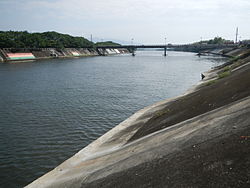Calumpang River
| Calumpang River | |
|---|---|
 Calumpang River in Batangas City | |
 Calumpang River mouth | |
| Location | |
| Country | Philippines |
| Region | Calabarzon |
| Province | Batangas |
| City/municipality |
|
| Physical characteristics | |
| Source | |
| • location | Rosario, Batangas |
| Mouth | |
• location | Batangas Bay |
• coordinates | 13°45′N 121°04′E / 13.750°N 121.067°ECoordinates: 13°45′N 121°04′E / 13.750°N 121.067°E |
• elevation | 0 m (0 ft) |
| Basin size | 472 km2 (182 sq mi)[1] |
| Discharge | |
| • location | Batangas Bay |
The Calumpang River (Tagalog: Ilog Calumpang) is a major river in eastern Batangas, Philippines. Known as the "Nile of Batangas," the river itself forms the southeastern boundary of Poblacion, Batangas City as it continues to flow southward to Batangas Bay at an approximately point of 2 kilometres (1.2 mi) east of Batangas Port.[1][2]
The river may derive its name from Sterculia foetida, a tree which whose local name is alternately spelled calumpang or kalumpang in Tagalog.[3]
Legends associated with the river[]
Legend has it that logs, locally known as batang, were floating all over the river. Batang is said to be the root word of Batangan, the former name of the capital city and the province.[4]
Another legend states that a statue of the Holy Infant Jesus on board a Spanish ship en route from Manila to Cebu sought shelter on the coast of city after its voyage was interrupted by a bad weather. The crewmen took the Holy Infant to a small church near the river and sang the Te Deum hymn. The storm miraculously stopped and the ship resumed its trip to Cebu. Soon, the statue was reported missing. At the same time, a deaf-mute boy who was playing along the river found the statue atop a floating log. In memory of this, a floral procession and a bangkarera or boat racing are held on the river every 16 January, the Catholic feast day of Batangas City.[4]
Conservation status[]
The river is now categorized as Class D; this means that its water can only be used for agriculture and manufacturing process after treatment. The factors causing water pollution in the river are direct disposal of household and livestock wastes and untreated sewage.[2]
In response, there have been efforts to revitalize the river most notably the Calumpang River Rehabilitation Campaign.[2][5]
See also[]
References[]
- ^ a b "Physical & Geographical Aspects". Local Government of Batangas City. October 20, 2014. Retrieved 24 June 2017.
- ^ a b c Mandane, Vaberlie M. (2013). "The Calumpang from My Window: Vision and Hope for the Batangas Nile". SENSUS COMMUNIS: the LATHE Journal 2013-2014. Batangas City, Philippines: The LATHE: Group of Publications: 178–179.
- ^ Edison (June 13, 2016). "Ilog ng Calumpang sa Batangas City". WOW Batangas (in Filipino and Tagalog). Retrieved 24 Jun 2017.
- ^ a b "The Storied Calumpang River". Batangas City Profile. Batangas City, Philippines: Local Government of Batangas City. July 23, 1999. p. 12.
- ^ Panaligan, Rose Ann (January 23, 2013). "Team Matalaw: The Noisemakers of Calumpang River". WOW Batangas. Retrieved 24 Jun 2017.
- Rivers of the Philippines
- Landforms of Batangas
- Asia river stubs
- Philippines geography stubs

